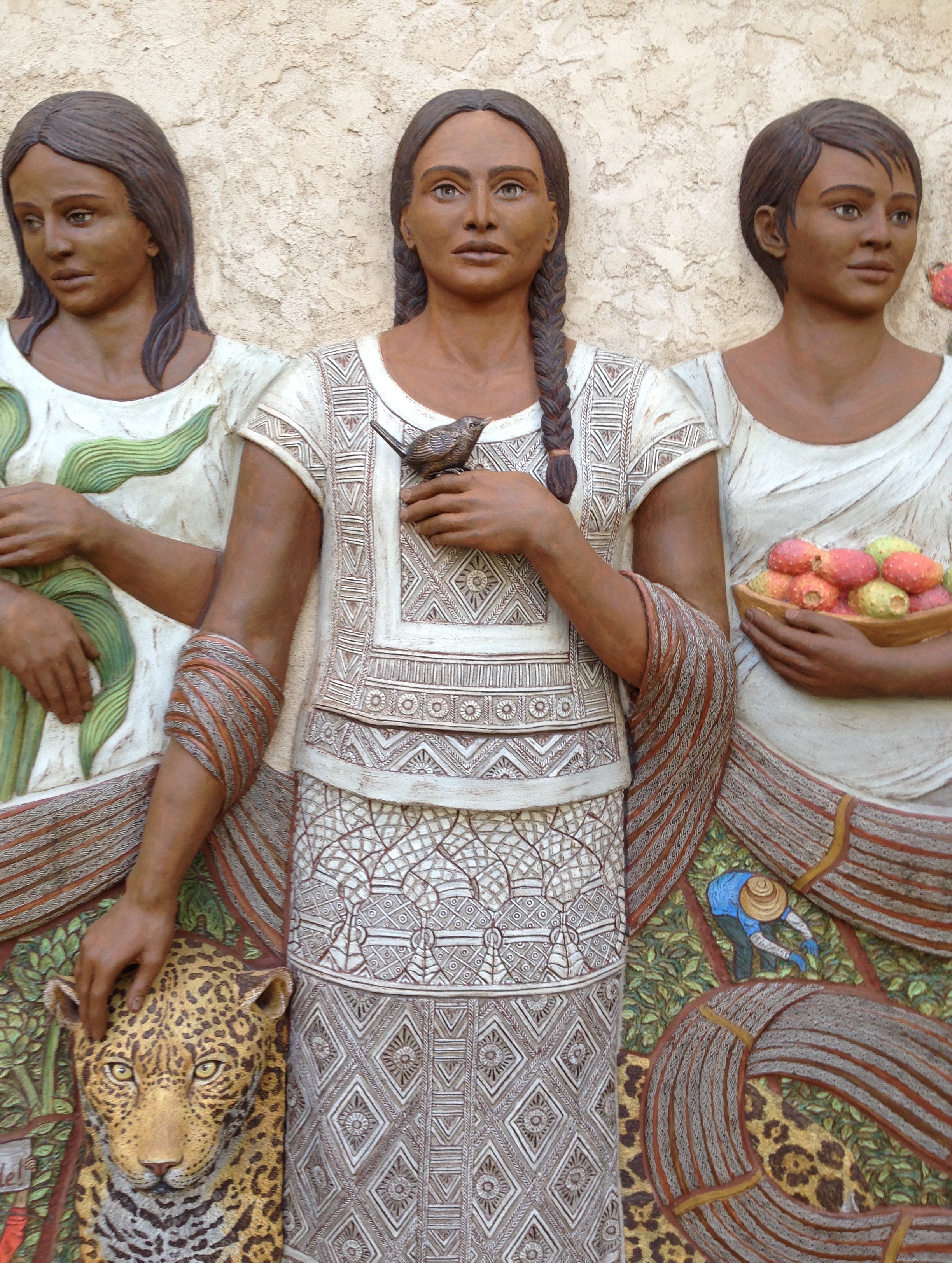
La Voz de Lupe
The Voice of Lupe
“The Voice of Lupe” honors and celebrates the role of Latina women in history and society, while also addressing ongoing issues of race, gender, and class on the UC Davis campus and in our society at large. It is a work that endeavors to inspire communication, understanding, positive action, and healing, in the hope for eventual mutual respect and equality.
The three female figures in the piece represent the collective “Voice of Lupe”, and they embody multiple trinities of symbolism: Past-Present-Future; Mother-Sister-Daughter; Wisdom-Courage-Strength; and Reflection-Activism-Healing. As one woman looks back, the other two represent the present and the path forward, and the three women speak with one voice through their intersecting and intergenerational identities. Together, they create the narrative of Latina women who are conscious of their history and their struggles as women, but who are also fully aware of their dignity, potential, and strength to persevere.
The figure on the left, La Mujer del Maiz (Woman of Maize), embodies Past, Mother, Wisdom, and Reflection. She looks back with sorrow at the injustices suffered by her people. However, she also reflects on the wisdom of her indigenous inheritance. The corn represents the concept of “Las Tres Hermanas”. “The Three Sisters” is the trio of Corn, Beans, and Squash native to Mesoamerica, an extraordinarily nutritious combination of food crops that made up the basis of the indigenous Mexican diet. Native cultivation practices of these three crops enriched the soil, reduced evaporation, and used agricultural land in a remarkably efficient and sustainable manner. This Mujer de Maiz, therefore, also connects us to the present, in that she represents the extraordinary contributions Mexican and Central American workers have made and continue to make to agriculture in California and the United States. The history, importance, and abundance of these contributions are celebrated in the imagery of the fields radiating out from the central figure of the mural.
The central figure, La Mujer del Jaguar (Woman of the Jaguar) embodies Present, Sister, Courage, and Activism. The Jaguar, a prevalent motif in Pre-Columbian art throughout Mexico and Central America, endures as a symbol of power and ferocity. It is an iconic image traditionally associated with the male warrior. With her right hand on its head, the woman claims the jaguar as her totem. In so doing, she adds her voice to the narrative, challenges harmful presuppositions regarding gender, race, class, and power, and she redefines what it means to be a warrior: the Woman Warrior has the courage to fight for her right to an education; she fights for her right to seek a better life for herself and for her family; she fights for her right to have control over her own body; she fights for her right to be treated with dignity and respect; she fights for her right to seek justice. Because the jaguar is a nocturnal creature, it is able to see in the darkness, thereby symbolizing the vision required to create a brighter future. Finally, its association with the night becomes a metaphor for women’s activism to “Take Back the Night”, and to claim the right to be safe from sexual objectification, aggression, and violence.
The Mujer del Jaguar holds her left hand close to her heart, and perched on her finger is a wren. A wren is a very small bird with an astonishingly bold and captivatingly beautiful and melodious song. The wren represents the power of song to inspire, to unify, to uplift, and to sustain. We have seen that power in important non-violent struggles for justice throughout our history: as in the song, “Follow the Drinking Gourd” in the Underground Railroad; as in “We Shall Overcome” in the Civil Rights Movement; as in “De Colores” in the Farmworkers’ Movement. The wren is a reminder for all of us to be aware of the way in which our words and actions can affect others, and to be true to our higher selves in our everyday lives and in our activism. Further, the wren symbolizes the importance of raising our voices in protest if the voices of others are hateful and harmful to us or to others.
The figure on the right, La Mujer del Nopal (Woman of the Prickly Pear Cactus), embodies Future, Daughter, Strength, and Healing. The Prickly Pear cactus is an ancient, nutrient-rich food source and medicinal plant native to the regions of the southwestern United States and northern regions of Mexico. Spanning the border, it represents our connection geographically, historically, culturally, and economically. Originating from Azteca/Mexica legend, the Nopal is an important symbol of homeland, of belonging, and of the strength needed to persevere in the course of a difficult journey. La Mujer del Nopal holds a bowl of tunas, the prickly pear fruit of the cactus, and is therefore a symbol of healing and hope as we look to the future.
The “Voice of Lupe” is resonant and clear: “I know who I am and I know where I came from. I will work toward a brighter future for myself and for my family with pride, courage, and dignity. I draw strength from my ancestry, from my own wisdom, and from my community of support. I have a right to an education; I have a right to be at this university; I have a right to be respected; I have a right to be free of discrimination, gender oppression, exploitation, and violence throughout my journey in life.”